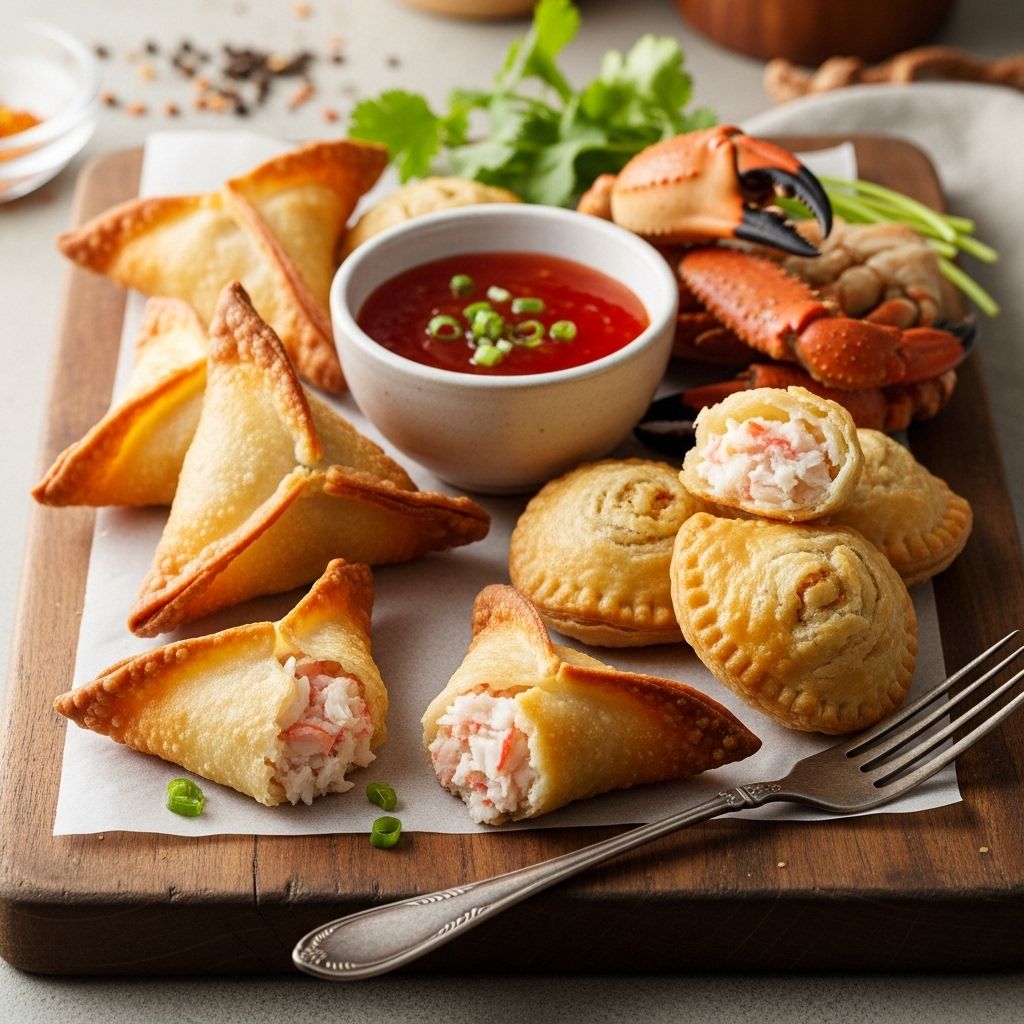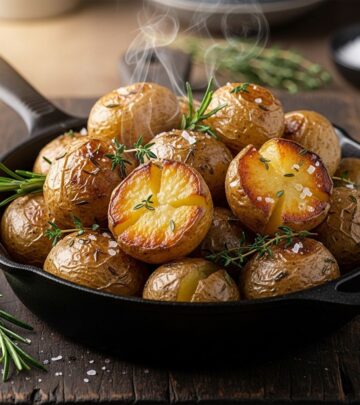Crab Rangoon and Crab Puffs: A Deep Dive Into An American-Chinese Icon
Discover foolproof folding techniques and the science behind ultra-crispy creamy wontons.

Crab Rangoon and Crab Puffs: The Ultimate Recipe and History Guide
Crab Rangoon—those addictive, crunchy, cream cheese-filled wontons—are a star at American-Chinese restaurants and takeout spots across the United States. Whether you call them Crab Rangoon, Crab Puffs, or cheese wontons, this savory snack’s appeal endures through generations, bridging East and West in a single bite. This guide explores the fascinating backstory, essential technique, filling tips, shaping, deep-frying science, and an in-depth step-by-step recipe for making irresistible Crab Rangoon at home.
Table of Contents
- A Short History of Crab Rangoon and Crab Puffs
- Recipe Overview
- Ingredient Science: Why Crab Rangoon Works
- Crab Rangoon (Crab Puffs) Recipe
- How to Fill and Shape Crab Rangoon
- Frying Techniques and Troubleshooting
- Serving Suggestions and Make-Ahead Tips
- Frequently Asked Questions
A Short History of Crab Rangoon and Crab Puffs
Crab Rangoon did not originate in China but is a classic of the midcentury American-Chinese restaurant movement. The legendary tiki bar Trader Vic’s in San Francisco claims the earliest printed recipe in their 1940s–50s menus. The dish likely evolved from a desire to fuse approachable, flavorful Asian ingredients (like wonton wrappers) with Western tastes (such as cream cheese, which is largely unknown in East Asian cuisine). Today, dozens of variations are found across buffets and takeout menus under names like “Crab Puffs,” “Cream Cheese Wontons,” and “Crab Cheese Wontons.”
- Origins: 1950s Trader Vic’s—San Francisco tiki culture and American fusion cuisine.
- Popularity: Now widespread among Chinese-American restaurants, buffets, and casual eateries.
- Misconceptions: Not a dish you’d find in China, but an American original inspired by Chinese culinary technique.
- Variations: Sometimes made with just cream cheese; the best include crab (real or imitation), scallions, and sweet dipping sauce.
Recipe Overview
This recipe for Crab Rangoon and Crab Puffs delivers a crunchy, golden-brown exterior and a savory, creamy, slightly tangy, and subtly seafood-tinged filling. The recipe can be adapted for frying or air-frying. It covers:
- Why the right cream cheese matters
- Fresh, canned, or imitation crab—what to choose
- Wonton wrappers: how to keep them supple and easy to work with
- Classic folding techniques for perfect puffs
- How to avoid leaks and soggy puffs
- The science of deep-frying for ultra-crispy results
Ingredients At-a-Glance
- Cream Cheese: softened, regular full-fat works best
- Dungeness, canned, or imitation crab: a scant amount for flavor and texture
- Scallions: thinly sliced for freshness
- Worcestershire sauce: for depth and subtle umami
- Garlic powder: for background savoriness
- Soy sauce: helps balance saltiness
- Wonton wrappers: fresh from the refrigerator section, not frozen
- Egg: for sealing wrappers
- Neutral oil: for deep frying (peanut, canola, or vegetable)
- Sweet chili sauce or duck sauce: for dipping
Ingredient Science: Why Crab Rangoon Works
Cream cheese is not traditional in Chinese cooking, but it’s the secret to Crab Rangoon’s signature creamy filling. Its primary role is to provide stability and a smooth, melt-away texture, resisting separation when fried. Adding crab (real or imitation) offers gentle seafood flavor. Scallions and aromatics cut through the richness, while a dash of Worcestershire sauce introduces a subtle umami backbone. Egg wash around the edges of the wrapper is essential for a tight seal and to prevent leaking during frying. Balancing moisture—not too wet, not too dry—is critical for both filling and wrapper integrity.
| Ingredient | Role | Tips |
|---|---|---|
| Cream Cheese | Binding, creamy texture | Soften before mixing; do not overbeat |
| Crab (real or imitation) | Savory seafood note | Drain canned thoroughly or pat imitation dry |
| Wonton Wrappers | Crunchy shell | Keep covered; dry out quickly |
| Egg | Adhesion of wrapper | Beat lightly, apply sparingly |
| Worcestershire, Soy Sauce | Depth, umami, seasoning | Mix in modest amounts to avoid sogginess |
Crab Rangoon (Crab Puffs) Recipe
This recipe yields approximately 24 crisp, golden Crab Rangoon. Allow 30–40 minutes total time, plus cooling.
Ingredients
- 8 ounces cream cheese, softened
- 4 ounces crab meat (real, imitation, or good-quality canned), drained and flaked
- 2 tablespoons finely sliced scallion greens
- 1 teaspoon Worcestershire sauce
- ½ teaspoon soy sauce
- ½ teaspoon garlic powder
- 1 large egg, beaten
- 24 wonton wrappers (square, fresh)
- Neutral oil for frying (such as peanut, canola, or vegetable)
- Sweet chili sauce (or duck sauce), for dipping
Instructions
- Prepare Filling: In a medium bowl, mix cream cheese, crab, scallions, Worcestershire, soy sauce, and garlic powder until fully combined. Taste and adjust seasoning if necessary.
- Set Up Wonton Assembly: Arrange wonton wrappers under a barely damp kitchen towel to keep moist. Beat the egg in a small bowl to use as an adhesive for sealing.
- Fill and Shape: Place about 1–1.5 teaspoons filling in the center of each wrapper. Brush egg wash around all four edges. Fold wrappers (see, How to Fill and Shape Crab Rangoon below for techniques) and press firmly to seal, removing any air bubbles.
- Heat Oil: Pour oil into a heavy-bottomed pot or wok to a depth of 2 inches. Heat to 350–365°F (175–185°C).
- Fry Crab Rangoon: Working in batches, gently slide filled wontons into oil, taking care not to crowd the pot. Fry, turning occasionally, until golden brown and crisp—2 to 3 minutes per batch. Use a spider or slotted spoon to remove to a paper-towel-lined tray.
- Cool and Serve: Allow to cool briefly. Serve hot with sweet chili or duck sauce for dipping.
How to Fill and Shape Crab Rangoon
The art of Crab Rangoon lies partly in its pleats and shapes. Folding techniques can dramatically affect frying and presentation. Here are the most popular methods:
- Triangle Fold: Place filling in the center, fold wonton wrapper diagonal corner to corner, forming a triangle. Press out air and seal all edges. Most common for home cooks.
- Four-Point/Star: Bring all four corners to meet above the filling, forming a star shape. Pinch seams together. Creates a classic Rangoon look and helps keep the filling contained.
- Envelope Fold: Fold two corners to meet in the center, then bring in the remaining corners for a tighter, compact dumpling. Useful for stuffing generously.
Tips for Perfect Shaping:
- Don’t overfill wrappers—too much filling can lead to messy leaks.
- Expel as much air as possible when folding to prevent bursting during frying.
- Seal all seams tightly using egg wash.
- Cover assembled rangoon with a moist towel as you work to prevent drying out.
Frying Techniques and Troubleshooting
The hallmark of true Crab Rangoon and Crab Puffs is their shattering crispiness. Here’s how to achieve consistently golden, crispy results, and avoid common frying pitfalls:
- Oil Temperature: Maintain at 350–365°F. Too cool? Rangoon absorb oil, turn soggy. Too hot? Exterior browns before filling heats.
- Batch Fry: Fry 4–6 pieces at a time; overcrowding drops oil temperature.
- Drain well: After frying, set puffs on a rack or paper towels to wick away excess oil.
- Watch for Leaks: Air bubbles or poor seals allow filling to escape. Seal tightly and use fresh wrappers.
- Frozen Rangoon: Can fry straight from freezer—just add 1–2 minutes to the cook time, watching closely for color.
- Air-frying Alternative: Brush filled rangoon lightly with oil, arrange in a single layer in basket, and air-fry at 375°F for 8–10 minutes, flipping halfway.
Serving Suggestions and Make-Ahead Tips
Done right, Crab Rangoon are best eaten immediately while piping hot. For parties or prep ahead:
- Keep Warm: Arrange fried rangoon on a wire rack set over a sheet tray in a low oven (around 200°F) for up to 30 minutes.
- Freeze Uncooked: Arrange shaped, uncooked puffs in a single layer on a tray, freeze solid, then transfer to freezer bag. Fry or air-fry directly from frozen.
- Dipping Sauces: Classic pairings include sweet chili sauce, duck sauce, or hot mustard. Try mixing sriracha with honey and lime for a modern twist.
- Leftovers: Reheat leftovers in a toaster oven or air fryer for best crispy texture. Microwaving will soften wrappers.
Frequently Asked Questions (FAQs)
Q: Is Crab Rangoon an authentic Chinese dish?
No—Crab Rangoon is an American-Chinese invention, likely first served at the tiki restaurant Trader Vic’s in the 1950s. It combines Chinese technique (wonton wrapper, deep frying) with American ingredients (cream cheese).
Q: Can I use canned or imitation crab?
Yes. Both are commonly used and work well in this recipe. Real crab gives the best flavor but is not essential; imitation (surimi) makes the dish affordable and tasty, while canned crab is convenient—just drain and flake it thoroughly.
Q: Why did my Crab Rangoon pop open during frying?
Air bubbles trapped inside or loose wrappers may burst during frying. Make sure to press out all air when sealing, use enough egg wash, and do not overfill.
Q: Are there vegetarian or gluten-free options?
To make vegetarian, omit crab or use finely chopped hearts of palm or artichoke. For gluten-free, use gluten-free wonton wrappers if available and certified gluten-free soy sauce.
Q: How far ahead can I make these?
Uncooked rangoon can be shaped and frozen for up to 1 month. Fry or air-fry straight from frozen (adding 1–2 additional minutes). Cooked crab rangoon are best the day they are made, but can be reheated in a warm oven or air fryer.
Q: What dipping sauces pair best with Crab Rangoon?
Classic: sweet chili sauce, duck sauce. For a homemade twist, combine honey, sriracha, and lime. Spicy mustard or soy sauce-based dips also work well.
Final Notes
Done well, crab rangoon encapsulate both nostalgia and deliciousness—crispy, creamy, just a bit indulgent. Master the simple secrets of moisture balance, sealing technique, and oil temperature, and you will have a party snack or takeout favorite that rivals any restaurant version. Enjoy experimenting with shapes, flavors, and modern twists, and share the joy of this uniquely American-Chinese classic at your next gathering.
Read full bio of Sneha Tete












